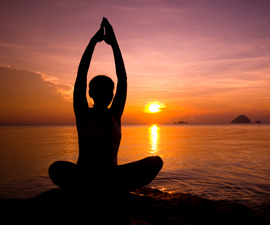Meditation 101
BASIC INSTRUCTIONS FOR MEDITATION ON THE BREATHSettle into the body. Experience what it is like to be alive in this body at this moment. Feel the vibration of life. Survey the “mood” states today…today’s weather. Energetic? Calm? Tired? Anxious? Peaceful? Fearful? Whatever you perceive. Don’t try to change anything, just notice.Take a moment to relax what is easily able to be relaxed. Soften the facial muscles. Relax and “unhinge” the jaw. Allow the shoulders to settle down. Soften the belly and hands. Reflect for a minute or two on some elements in your life that you are grateful for. “Feel” what gratitude really feels like. Bask in that feeling. To further enhance receptivity allow a “smile” into the mind, eyes, heart and lips. Open to sound. Resting back like a satellite dish, not chasing the sounds, very alert and accepting of whatever sounds are occurring. Hearing with the quality of “bare attention” undefined feeling the energy of the sound without trying to analyze, categorize, or figure the sound out. Allowing the sound to “wash through” un-resisted. Allowing yourself to be massaged by the sound. Notice that you can hear without any effort. Sound just arises and passes by itself in the open, spacious, skylike awareness of the mind. Now, moving the attention to the body. Experience some of the “touch points” of the body. The pressure on the sitting bones, the touch of feet on the floor, the touch of the hands wherever they are resting, the touch of the clothing and touch of the air moving across exposed skin are all “touch points.” Feel the overall sensations of pulsing life in the body. Noticing that these sensations arise and pass away just like sounds in the open, spacious, skylike quality of the mind. Notice now that breathing is happening…..by itself. Explore the breath. What is it like? Long? Short? Deep? Shallow? Smooth? Coarse? Forced? Easy? Etc. Find the portion of the breath that is most predominant and comfortable for you and make that portion of the breath the “refuge,” the “anchor” or “home base” for this sitting period. Rest in your anchor and observe all the nuances of today’s breath. Experience the gently rocking motion of the breath, the primordial ebb and flow of the breath. You may want to try supporting the mind being with the breath by using a quiet notation in the mind like rising-falling or in-out etc. Noting with a voice in the mind about as heavy as a dragonfly’s wing. Bring yourself up close to the breath. Be snug but gentle with it as if you were carrying a baby in a Snugli. Not too tight but not too loose. See if you can develop a reverence and affection for the sacred breath that has served you so well. When the mind is pulled away from the breath (which is OK and completely natural), eventually you become aware that you were off thinking in some way and now you are back in “presence.” Notice the difference between being awake right now and being lost in planning, remembering, fantasizing etc. Rest for some moments in the wakefulness you have re-discovered. This sensitizes your organism to the wakeful presence of “now”. It helps re-organize the nervous system to rest in the moment instead of churning the anxiety of past or future. Now, before you return to the breath relax the facial muscles, jaw, neck and release any other felt tension in the body on your non-hurried way back to the breath. Take your time. This pause for relaxation is very important. There is no hurry. No place to go. These moments of relaxation are as important as any other part of the meditation. If at any time you feel confused or you are starting to get very tight, throw open your awareness to experience the touch points of the body or sounds. Relax back and just feel the sensations of the touch points or allow the sounds to wash through for a while. When you feel settled again, go back to the breath. Helpful Hint: If as you are noticing today’s “internal weather” is sleepy, tired or sluggish pay particular attention to the in-breath. The in-breath brings energy into the system, oxygen to all the cells. Paying specific attention here will, in many cases, enliven the system and our attention becomes sharper. If on the other hand you feel anxious, restless or nervous pay particular attention to the out-breath. The out-breath is a “letting go,” a releasing of tension. ~Pat Coffey, Co-Founder, Insight Meditation Community of Charlottesville, 2009
|  |